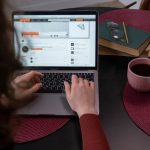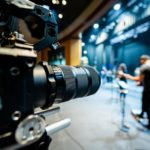Audio Engineering: Your Home Recording Studio! The digital age has made it possible for almost anyone to set up a home recording studio with the right equipment. We’re seeing more artists record and distribute independently as a result. And it isn’t as difficult or expensive as you might think. You don't need a high-end setup for good-quality recordings.
Learning how to set up a home recording studio gives you the freedom to record when you want, how you want. You could probably begin with the computer you have and an inexpensive audio interface. Then all you need are some decent monitors or headphones and a MIDI keyboard. All that’s left is a good DAW to tie it all together.
The following is a list summarizing the key elements needed to set up a home recording studio:
- Set Up Your Space
- Get a Suitable Computer
- Find DAW Software
- Buy a Digital Audio Interface
- Choose Your Microphone
- Invest in a Preamplifier
- Select Your Studio Monitors or Headphones
- Look for a MIDI Keyboard
You may get access to DAW (Digital Audio Workstation) software if you buy your audio interface or MIDI keyboard new. Software such as Ableton Live, Pro Tools, and Cubase are sometimes included. However, there are also decent free DAWs for you to use, which you can download online.
Bear in mind that the equipment you need may vary from one style of music to another. For instance, recording electronic music will require slightly different tools to record live instruments and vocals. And with the correct equipment, you could be producing premium quality music right from your bedroom.
This blog post will cover all the basics required to set up a home recording studio for your needs. With our helpful tips, you’ll be recording and distributing your music in no time.
Get Started: Home Recording Studio Tips
Specific vital components are required to set up a phenomenal home recording studio. Here, we'll break down the most essential elements and what you should look out for.
1. Audio Engineering and Your New Home Recording Studio: Set Up Your Space!
Your first port of call is to determine which room you'll use as a recording studio in your house. The rooms of a residential building are simply not intended for the purpose of recording music. So, there are specific characteristics you need in a room when you set up a home recording studio.
The room should be a dead space or as close as possible. In other words, you want to avoid unnecessary noise and echoes. And certain surfaces and materials can help you achieve this.
A carpeted floor and solid wooden door that can close will help to dampen and absorb background noise. And the fewer windows you have in the room, the better. In fact, if you have a room in the house without windows, this would be ideal.
Soundproofing your chosen room is just as important. This can be done using professional acoustic foam sound absorbers, but that can be pricy. The alternative is to make your own using foam padding or boards covered in thick fabric. You'll want a few sound absorbers along each wall and larger bass absorbers over the corners of the room.
If you have a sizeable closet in the room, you could always use it as a noise-canceling sound booth. It's a great way to create an even quieter space to record, free from potential reverb. You could even leave your clothing in the closet as an added buffer.
Don't forget to ensure you have a suitable chair and desk to work at. Remember that you'll likely be spending several hours working here at a time. So, the chair and desk must create a comfortable workspace.

2. Audio Engineering and Your New Home Recording Studio: Get a Suitable Computer!
Honestly, the desktop or laptop computer you currently use at home should be sufficient. You'll just need to ensure that there's enough space to download the DAW software and save a few projects you're working on.
Remember that you'll be recording and saving large audio files. And it's not ideal to save these all to your computer. Therefore, ensure you have sufficient external or cloud-based storage space to save past, current, and future projects.
Having a dedicated computer for your home recording studio would be first prize. But, if your budget doesn’t allow for it, don’t worry. Your personal computer will be just fine at the start.
3. Audio Engineering and Your New Home Recording Studio: Find DAW Software!
If this is your first time looking at how to set up a home recording studio, then you may be unsure about which DAW to go with. Selecting a specific DAW brand is not critical as they all come with the same basic functionality. And when you're starting out, you don't need anything too elaborate.
In fact, some of the top names in the industry offer free simplified versions of their software. This includes Ableton Live Lite from one of the biggest DAW developers in the world. And most of these will be perfectly sufficient for recording a few vocal, guitar, or electronic tracks.
Remember that some of the equipment you’ll buy to set up a home recording studio will come with DAW software. It's often the basic freebie versions that are included. But you do also get more comprehensive DAW software with particular items. For instance, all Lexicon audio interface devices come with a slightly stripped-down Cubebase DAW.
4. Audio Engineering and Your New Home Recording Studio: Buy a Digital Audio Interface!
You’re going to need an audio interface device with two inputs and two outputs. And if you can find one that gives you the option to change your inputs from line to instrument inputs, even better.
Purchasing a digital audio interface or digital audio converter (DAC) can be tricky, primarily if you've never used one before. In its simplest form, an audio interface transforms your analogy audio into digital form so you can work with it in your DAW. But a more advanced audio interface can provide you with other functions.
Buying an audio interface can be expensive, but you don’t need a top-of-the-line one when starting out. Essentially, you’re going to need an audio interface device with two inputs and two outputs. And if you can find one that gives you the option to change your inputs from line to instrument inputs, even better.
This way, you'll be able to plug your mic, drum machine, and live instruments into the audio interface. An audio interface with one or two inputs would be considered an entry-level device. But this should be sufficient when starting out. If budget is an issue, look for a second-hand audio interface to buy.
A popular two-channel digital audio interface is the Focusrite Scarlett 2i2. This device has a built-in preamp, and the latest model, third-generation, will cost you around $200 new. However, you may be able to pick up a second-hand first-generation Focusrite Scarlett 2i2 for less than $100. The first-generation model will serve you well.
5. Audio Engineering and Your New Home Recording Studio: Choose Your Microphone!
Another vital element when you set up a home recording studio is your microphone. Microphones come in various styles and sizes, each with its merits. But, when starting out, you'll want something versatile and cost-effective.
Microphones are classed into three categories, namely condenser, ribbon, and dynamic mics. The difference between the three essentially comes down to how they convert sound into audio. And each has its strengths in different situations.
Dynamic microphones are inexpensive and highly durable. They’re also not as sensitive as other microphones. This means they’re perfect for recording louder instruments like drums.
Condenser mics are more complex, delicate, sensitive, and expensive than dynamic microphones. However, due to their sensitivity, the sound produced is clear and crisp. And they are, therefore, great for recording gentler, sharper sounds.
Before dynamic and condenser microphones came to be, much of the music before the 1970s was recorded using ribbon mics. These are very fine and costly microphones. But they produce a uniquely warm and textured vintage sound.
That said, independent recording studios lean on dynamic mics for recording vocals and instruments. Due to their robust nature, these mics are just as valuable for the studio as they are on stage.
Many industry experts advise that you should invest in the Shure SM57 dynamic microphone if you can afford it. It's said to be a robust and reliable tool in recording studios worldwide. But perhaps you're looking to equip your home recording studio with a few microphones. In that case, it's best to get a mix of condenser, ribbon, and dynamic mics.
When purchasing your microphones, remember that you'll need an XLR cable and stand for each. You should also consider buying pop filters that help eliminate unwanted noise when recording vocals.
6. Audio Engineering and Your New Home Recording Studio: Invest in a Preamplifier!
Most digital audio interfaces come with a built-in preamplifier. But if yours doesn’t have one, you’ll need to purchase an external preamplifier device.
A preamplifier, or preamp, is a device that runs between your digital audio interface and your microphone. Preamps are essential when powering converter mics. But a preamp is unsuitable for ribbon mics and will permanently damage them.
Running your dynamic or converter mic through a preamp brings life and texture to any vocals or instruments recorded. And many sound engineers believe they should be an essential part of any recording studio.

7. Audio Engineering and Your New Home Recording Studio: Select Your Studio Monitors or Headphones!
Granted, you can set up your home recording studio using a computer or other speakers you already have. But these won't give you an accurate representation of the audio on playback. Speakers intended purely for music playback are set up to make the music more pleasant to listen to. They tend to deliver stronger mid-range and bass sounds, making most music more pleasurable to the ear.
While studio monitors look like regular speakers, they’re built to deliver the most authentic sound possible. In other words, on playback, the audio is clean, stripped down, and true to the quality of the recording. This allows music producers and sound engineers to pick up on any inconsistencies in the music.
Using studio-grade monitors in a soundproofed room will provide you with the best possible representation of what you've recorded. And then, you can adjust the music or re-record as needed.
That said, because you're about to set up a home recording studio, chances are there'll be other people in the house. And, as such, you may not have the luxury of playing the recording back through monitors. You'll need to invest in a solid pair of studio headphones in this instance.
Like studio monitors, studio headphones are designed to be used in the recording studio. Closed-back studio headphones are ideal for recording as they keep the sound locked in. While open-back studio headphones are suited to mixing and mastering.
One of the most praised headphones in the industry is the ATH-M50x set of studio headphones by Audio-Technica. Although they’ll set you back approximately $150. If you’re on a budget, you should be able to pick up adequate studio headphones for as little as $20.
8. Audio Engineering and Your New Home Recording Studio: Look for a MIDI Keyboard!
While a MIDI keyboard might not be an absolutely essential piece of equipment, it's a useful tool to have in your arsenal. It doesn't matter if you're not producing electronic music, creating beats, or using digital instrument sounds. Your MIDI keyboard could simply be a small instrument used to streamline your workflow.
That said, if you leverage the full capabilities of a MIDI keyboard, you’ll have a world of options at your fingertips. And you don’t need a full-sized keyboard to achieve fantastic results.
One of the best-loved MIDI keyboards for home recording studios is the Komplete Kontrol M32 by Native Instruments. And you're likely to pick a new one up for under $150. What's more, is this MIDI keyboard integrates well with Ableton Live software. And Native Instruments also offers a free production suite bundle called Kontrol Start, which anyone can download from their website.
Conclusion
As you tell, it's not too tricky to set up a home recording studio. But it will require some capital outlay. However, look for good quality second-hand equipment. This way, you could set up a home recording studio for as little as $350 in total.
That said, bear in mind that you'll also need to purchase cabling for all your equipment to function. And, further down the line, you'll want to invest in a comfortable chair and studio desk. Desks designed for use in the studio will offer you increased comfort, space, and organization.
When you’ve recorded, mixed, and mastered that first track, and you’re ready to release, give Sugo Music Group a call. With 35 years of experience in music distribution and publishing, their experts have a wealth of knowledge to share. Their team will provide you with the advice you need to release your song seamlessly and successfully.









